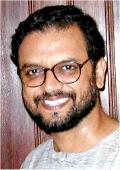The Independent Newsweekly
| National
Catholic Reporter
The Independent Newsweekly |
| Global Perspective |
| September 3, 2003 |
Vol.
1, No. 23
|

Fr. Francis Gonsalves is a Jesuit in the Gujarat Province, India. He lectures in systematic theology at Vidyajyoti College of Theology, Delhi, and has published many articles on theology, spirituality and social justice. While monasticism and Puritanism of the West have often led to utter neglect of the body or narcissism, Indian spirituality values the body. The body is a true shrine within which to meet God. |
Meditating and Medicating on the MarginsBy Francis Gonsalves, S.J. While most believers raise their hands in worship, Catholic priest Swami Devaprasad, who harmonizes hatha yoga with Christianity, frequently raises his feet, too. In Pune, Buddhists are thrilled that Fr. Peter D'Souza conducts vipassana courses and that Medical Mission Sr. Ruth Manianchira heals hundreds through reiki. Fr. Joe Pereira of Mumbai cures alcoholics and drug addicts through yoga, while in South India, Jesuit priests Ama Samy and Sebastian Painadath run Zen courses and Bhagavad Gita retreats, respectively, with rousing response. Spirituality, not doctrine -- the human body, not merely the mind -- is the meeting ground of India's modern missionaries who meditate and medicate on the margins between Catholicism and Indic religions. Moreover, their margin-ministries are moving the Indian church toward rediscovering the Indian Christ, and refurbishing Indian Christian-ness. The unitive force of spirituality
"Though we come from different religions, we all meet at the level of spirituality," asserts Painadath, whose Gitasadhana "is an intense initiation into contemplative prayer based on the integrated spiritual transformation undergone by Arjuna under the impact of the divine Lord traced in the Bhagavad Gita." D'Souza explains that, "By turning one inward, vipassana leads one to the depths of Christianity, to the heart and lap of Christ." He adds, "the priest is a guide leading people to deeper waters." Likewise, reiki -- meaning, "spiritually guided life force energy" -- helps Manianchira unleash channels of spiritual power that lie latent within the depths of being. Indeed, the wellsprings of all religions surge from these spiritual depths. Rediscovering the body
Manianchira is enthusiastic about the healing powers of reiki: "a wonderful glowing radiance that flows through you, surrounds you, and treats the whole person -- body, emotion, mind, spirit -- creating extraordinary effects like relaxation, peace, security, well-being, and other miraculous results." The 'just sitting' human body in shikantaza or zazen is fundamental to the Zen tradition. This entails being fully present in the here and now, or as Ama Samy phrases it, "Just be-ing in one's bodily fragility and inter-connectedness with the whole universe. It is a body-mind practice, a somatic act of mindfulness engendering detachment, equanimity, and holy indifference -- a practice of letting-go and letting-be." While monasticism and Puritanism of the West have often led to utter neglect of the body or narcissism, Indian spirituality values the body. "The body is a true shrine within which to meet God," stresses Devaprasad. The social dynamism of spirituality
In conformity with the charism of the Medical Missionaries in India, Manianchira has jettisoned the "hospital model" or "medicine-dispensing model" in favor of "not merely removing symptoms but addressing the root causes of illness which lie at the very depths of our being." She strives for 'integral healing' and 'sustainable health' for all. "There is no place for rituals in vipassana," explains D'Souza. "Yet, vipassana helps one enjoy and appreciate the deeper meaning of rituals." Transcending religious rituals through an institution called Maher in Pune, practitioners of vipassana strive to live a communitarian life while implementing socio-educational programs for the poor. Rechristening Christ in India
Consequent to the crisscrossing of creedal confines, conceptions of Christ change. Pereira and Swami Devaprasad unanimously worship Jesus as "The Supreme Yogi" who proclaimed, "I am in the Father and the Father in me" (John 14:11). Manianchira admits to calling upon the power of "Jesus the Healer" to empower her in her mission. "I often see Jesus as a reiki practitioner," she confesses, "who preaches forgiveness and love as means of wholeness." A Hope for Holism
Among the ecclesiastical hierarchy, there is mixed response toward incorporating Indic spiritual systems into Christianity. Some bishops and priests support such moves. Others stump them. Surprising. A January symposium organized by the Pontifical Council for Interreligious Dialogue in Rome categorically confirmed: "We recognize that in the interrelated context of our contemporary lives, interreligious cooperation is no longer an option but a necessity."* Hopefully, Jesus the reiki Healer will draw us toward holism, and Jesus the Yogi will unite us to all peoples, nature, God. *Final declaration of the participants in the symposium on spiritual resources of the religions for peace. Rome, January 16-18, 2003. |
| Copyright
© 2003 The National Catholic Reporter Publishing Company, 115
E. Armour Blvd., Kansas City, MO 64111
TEL: 1-816-531-0538 FAX: 1-816-968-2280 |